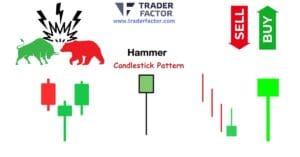The Shooting Star candlestick pattern is a prominent bearish reversal signal that traders watch for at the peak of an uptrend. This single-candle formation provides a powerful visual cue that bullish momentum may be waning and a potential downward price move is on the horizon. For traders new to technical analysis, understanding the characteristics and implications of the Shooting Star candlestick pattern is a fundamental step toward identifying potential market tops and managing risk effectively.

Table of Contents
ToggleUnderstanding the Anatomy of the Shooting Star Candlestick Pattern
To effectively interpret the signals from a Shooting Star candlestick pattern, it is essential to understand its specific anatomy.

This pattern is defined by its distinct shape, which tells a story of a failed attempt by buyers to push prices higher.
It consists of a small lower body, a long upper wick that is at least twice the length of the body, and little to no lower wick. The formation of this candle after a series of bullish candles suggests that sellers have stepped in forcefully, rejecting higher prices and signaling a potential shift in market control. The proper identification of the Shooting Star candlestick pattern is crucial for its use as a reliable bearish indicator.
The Long Upper Wick: The Battle’s Story

The most defining feature of the Shooting Star candlestick pattern is its long upper wick.
This wick represents the price action during the trading session, showing that buyers initially pushed the price significantly higher, continuing the prior uptrend. However, this upward momentum was not sustained. Before the session closed, sellers entered the market with enough force to push the price all the way back down near its opening level. This price rejection at the highs is the core narrative of the Shooting Star candlestick pattern, visually demonstrating that the bulls are losing their grip.
The Small Body: A Sign of Weakness
The small body at the lower end of the candle is another critical component of the Shooting Star candlestick pattern. It indicates that the closing price was very close to the opening price, showing indecision and a stall in bullish momentum. The color of the body, whether it’s a bullish (green) or bearish (red) candle, is less important than the overall structure, though a red body can suggest slightly more bearish pressure. A green shooting star candlestick still functions as a bearish reversal signal because the long upper wick, signifying price rejection, is the most important element of the Shooting Star candlestick pattern.
Identifying a Valid Shooting Star Candlestick Pattern
Spotting a valid Shooting Star candlestick pattern requires more than just seeing a candle with a long upper wick; it involves confirming that the pattern appears in the correct context.

Its reliability as a bearish reversal signal is heavily dependent on its position within a market trend.
Misinterpreting this signal can lead to premature short entries and potential losses. Therefore, traders must be diligent in verifying that the formation meets all the necessary criteria before considering it a true Shooting Star candlestick pattern.
The Preceding Uptrend is Key
The most important rule for identifying a genuine Shooting Star candlestick pattern is that it must appear after a clear and sustained uptrend. The pattern’s significance comes from its ability to signal the potential end of a period of buying pressure. If this formation occurs during a downtrend or in a sideways, ranging market, it loses its bearish implication and should be disregarded. The context of the preceding rally is what gives the Shooting Star candlestick pattern its power, as it signals a possible exhaustion of the bullish move.
Confirmation: The Follow-Through Candle
While the Shooting Star candlestick pattern itself is a strong warning sign, traders often wait for further confirmation before entering a trade. This confirmation typically comes from the next candle. A bearish confirmation candle is one that opens and closes below the low of the Shooting Star. This follow-through action validates the bearish sentiment, showing that sellers have indeed taken control and are pushing the price lower. Without this confirmation, the signal from the Shooting Star candlestick pattern is less reliable.
The Psychology Behind the Shooting Star Candlestick Pattern
The power of the Shooting Star candlestick pattern lies in the market psychology it reveals. The pattern captures a single trading session where the balance of power shifts dramatically from buyers to sellers. Initially, the market continues its uptrend, reflecting bullish optimism. Buyers push prices to new highs, but at this peak, sellers emerge in force, rejecting the higher prices and driving them back down. This swift reversal within a single candle shows that bullish conviction has evaporated and been replaced by selling pressure, a key story told by the Shooting Star candlestick pattern.
From Bullish Optimism to Rejection
The formation of the Shooting Star candlestick pattern begins with the bulls firmly in control, carrying the momentum from the preceding uptrend. They manage to push the price significantly higher during the session, creating the long upper wick. This moment represents peak optimism. However, this high is short-lived as sellers step in, seeing the price as overvalued. Their selling pressure is so strong that it completely reverses the session’s gains, a classic sign of rejection which is central to the Shooting Star candlestick pattern.
The Bearish Takeover Signal
The close of the candle near its opening price solidifies the narrative of a bearish takeover. The inability of the bulls to hold the price at its highs demonstrates their exhaustion and the new strength of the bears. This single candle acts as a powerful warning that the uptrend may be over. This psychological shift is what makes the Shooting Star candlestick pattern such a closely watched signal for traders looking to anticipate a market top and potential reversal.
Distinguishing the Shooting Star Candlestick Pattern from Other Patterns
To avoid confusion and false signals, it’s essential to differentiate the Shooting Star candlestick pattern from other similar-looking candlestick patterns. For instance, the Hammer, Inverted Hammer, and Hanging Man all have shapes that can be mistaken for a Shooting Star. However, each has a different meaning based on the market context in which it appears. Correctly identifying these candlestick patterns is fundamental to accurate technical analysis and successfully trading the Shooting Star candlestick pattern.
Shooting Star Candlestick and Hanging Man

The Shooting Star candlestick and Hanging Man patterns look identical, with a small body, long upper wick, and little to no lower wick. The key difference is the trend in which they appear.
The Shooting Star candlestick pattern is a bearish reversal signal that occurs at the top of an uptrend. In contrast, the Hanging Man appears at the top of an uptrend as well, but it is often considered a warning of a potential top, with the Shooting Star being a more definitive reversal pattern. A clear understanding of this contextual difference is vital for interpreting the Shooting Star candlestick pattern correctly.
Shooting Star vs. Hammer Candlestick

The Hammer candlestick is the bullish counterpart to the Shooting Star candlestick pattern.
A Hammer has a small upper body, a long lower wick, and little to no upper wick, appearing at the bottom of a downtrend. It signals a potential bullish reversal, as sellers pushed the price down but buyers brought it back up. The Shooting Star candlestick pattern, conversely, is bearish. Confusing the two could lead a trader to prepare for a price rise when a drop is more likely.
Formulating a Trade with the Shooting Star Candlestick Pattern
Developing a clear strategy is essential for trading the Shooting Star candlestick pattern effectively. This involves more than just identifying the pattern; you need a plan for entry, stop-loss placement, and profit targets. Simply seeing the pattern and entering a short trade is not enough for consistent results. A systematic approach, like a well-defined bullish shooting star candlestick strategy for when the pattern fails, or a bearish one when it succeeds, is necessary to manage risk and capitalize on the opportunities presented by the Shooting Star candlestick pattern.

Entry Strategy After Confirmation
A common entry strategy for the Shooting Star candlestick pattern is to place a sell order after the confirmation candle has closed. As mentioned, this is typically the candle that follows the Shooting Star and closes below its low. Some traders might enter a short position once the price breaks below the low of the Shooting Star itself, without waiting for the next candle to close. This is a more aggressive entry. Regardless of the specific trigger, waiting for some form of confirmation is a key part of trading the Shooting Star candlestick pattern.

Setting Your Stop-Loss and Take-Profit Levels
Proper risk management is crucial when trading the Shooting Star candlestick pattern. A logical place for a stop-loss is just above the high of the Shooting Star’s wick. This protects your trade against a failed signal where the price continues to move higher. For take-profit targets, you can look for previous support levels on the chart or use a fixed risk-to-reward ratio, such as 2:1. This structured approach to managing your trade is essential for long-term success with the Shooting Star candlestick pattern.
Advanced Concepts: Types of Shooting Star Candlestick Patterns
While the basic formation is straightforward, traders can encounter variations of the Shooting Star candlestick pattern that add nuance to the analysis. These variations, such as a double shooting star or a shooting star that is part of a larger pattern, can provide even stronger signals. Understanding these different types of Shooting Star candlestick patterns allows for a more refined approach to trading and can help in identifying higher-probability setups.

The Double Shooting Star Candlestick Pattern
A double shooting star candlestick pattern occurs when two consecutive Shooting Stars form at the top of an uptrend. This back-to-back formation of price rejection is a very strong bearish signal. It indicates that the bulls attempted to push the price higher on two separate occasions but were rejected by sellers both times. This repeated failure to advance the price adds significant weight to the bearish reversal signal, making the double Shooting Star candlestick pattern a high-conviction setup for short sellers.

The Reverse Shooting Star Candlestick Pattern
The reverse shooting star candlestick, more commonly known as the Inverted Hammer, has the same shape as a Shooting Star but appears at the bottom of a downtrend. While it looks like a Shooting Star, its placement in a downtrend gives it a bullish reversal meaning. It suggests that buyers are starting to test the waters, even though sellers managed to push the price back down. Recognizing the difference between a Shooting Star and a reverse shooting star candlestick is crucial for correct analysis.
The Shooting Star Candlestick Pattern in a Broader Context
The Shooting Star candlestick pattern is a powerful signal, but its reliability increases when it is considered alongside other technical patterns and indicators. For example, its appearance as part of a larger bearish formation can amplify its significance. It is rarely traded in isolation by experienced analysts. By viewing the Shooting Star candlestick pattern as one piece of a larger puzzle, traders can build a more comprehensive market view.

Connection to Evening Star Candlestick
The Shooting Star candlestick pattern can sometimes form as the second candle of an Evening Star candlestick pattern. The Evening Star is a three-candle bearish reversal pattern consisting of a large bullish candle, a small-bodied candle (like a Shooting Star), and a large bearish candle. When a Shooting Star appears as the middle candle, it strengthens the signal of the broader Evening Star formation, providing a powerful confluence of bearish signals.

Contrast with Morning Star Candlestick
In contrast to the bearish implications of the formations involving a Shooting Star, the Morning Star candlestick is a three-candle bullish reversal pattern found at the bottom of a downtrend. It signals a potential shift from bearish to bullish momentum. Understanding both patterns helps traders recognize potential tops with the Shooting Star and potential bottoms with the Morning Star candlestick, providing a balanced view of market reversal opportunities.
Reading the Shooting Star Candlestick Chart
Being able to read a Shooting Star candlestick chart is a fundamental skill for a technical trader. It involves scanning price action for the specific criteria of the pattern within the context of an uptrend. A single Shooting Star candlestick chart provides a snapshot of the battle between buyers and sellers, offering a clue about a potential change in direction. Practice and screen time are key to quickly and accurately identifying a potential setup based on the Shooting Star candlestick pattern.

Practical Example on a Chart
Imagine a stock has been rising for several days, creating a clear uptrend on its daily chart. Then, a candle forms that opens at $50, rallies up to $53, but closes back down at $50.50, creating a long upper wick. This is a classic Shooting Star candlestick chart example. If the next day’s candle opens and closes lower, say at $49, it confirms the bearish signal of the Shooting Star candlestick pattern, suggesting the uptrend is likely over.

Bullish Shootings Star Candlestick Chart Scenario
What happens if the pattern fails? This is where a bullish shootings star candlestick chart scenario comes into play. If a Shooting Star forms but the next candle opens and closes above the high of the Shooting Star, the bearish signal is invalidated. This failure is actually a sign of bullish strength, indicating that despite the intraday rejection, buyers were strong enough to absorb the selling pressure and push prices higher. This failed Shooting Star candlestick pattern can be a signal to stay in or enter a long position.
Common Questions: Is a Shooting Star Candlestick Bullish or Bearish?
One of the most frequent questions from beginners is about the directionality of the pattern. So, is a shooting star candlestick bullish or bearish? The answer is clear: the Shooting Star candlestick pattern is unequivocally a bearish reversal signal. It indicates that an uptrend is potentially ending and that prices may be about to fall. Its entire structure is built around the story of bulls failing and bears taking control.

Why is it Considered a Bearish Signal?
The Shooting Star candlestick bearish signal is derived from the long upper wick. This wick shows that the market tested higher prices during the session but failed to sustain them. This rejection by sellers is a strong indication that the buying pressure that fueled the uptrend is exhausted. The formation of the Shooting Star candlestick pattern implies that the path of least resistance has now shifted to the downside.

The Myth of the Bullish Shooting Star Candlestick
The term “bullish shooting star candlestick” is a misnomer and often causes confusion. A pattern with the shape of a Shooting Star that has a bullish implication is called an Inverted Hammer and it must appear after a downtrend. When the classic Shooting Star candlestick pattern appears after an uptrend, it is always a bearish signal. Any bullish shooting star candlestick strategy would be based on the failure of the pattern, not the pattern itself being bullish.
Resources for Learning More About the Shooting Star Candlestick Pattern
For traders looking to deepen their understanding, there are many resources available. From books on Japanese candlestick charting to online articles and videos, the information is plentiful. Many traders find a shooting star candlestick pdf guide useful for a quick reference, as it can be saved and reviewed offline. These guides often contain visual examples and trading rules that reinforce the concepts.

Finding a Good Shooting Star Candlestick PDF
A quality shooting star candlestick pdf will provide clear diagrams, define the pattern’s criteria, and offer examples of both successful and failed patterns. It should detail entry, stop-loss, and exit strategies to provide a complete trading framework. Searching for resources from reputable financial education websites can help you find a reliable guide to the Shooting Star candlestick pattern.

Other Essential Candlestick Patterns
To become a well-rounded trader, it is important to study the Shooting Star candlestick pattern in conjunction with other key patterns. Understanding formations like the Hammer, Doji, Engulfing patterns, and the Morning Star and Evening Star will provide a more complete understanding of how to read price action. Each pattern offers a unique insight into market psychology and can be used to build a robust trading system.
Conclusion
In conclusion, the Shooting Star candlestick pattern is an essential tool for traders to have in their technical analysis toolkit. As a single-candle bearish reversal pattern, it provides an early and clear warning that an uptrend may be losing momentum and a reversal is possible. By understanding its anatomy, the psychology behind it, and the importance of confirmation, you can use this signal to identify potential shorting opportunities or to protect profits from long positions. While no pattern is foolproof, a disciplined approach to trading the Shooting Star candlestick pattern can significantly enhance your market timing and overall strategy.
Frequently Asked Questions

What is a Shooting Star candlestick?
A Shooting Star is a single-candle bearish reversal pattern that forms at the top of an uptrend. It has a long upper wick, a small lower body, and little to no lower wick.
Is a Shooting Star candle bullish or bearish?
A Shooting Star candle is bearish. It indicates that buyers pushed the price up, but sellers took control and pushed it back down, signaling a potential trend reversal to the downside.
What is the difference between a Shooting Star and a hammer?
A Shooting Star appears at the top of an uptrend and is bearish. A Hammer appears at the bottom of a downtrend and is bullish, despite both having similar small bodies.

How do you trade a Shooting Star pattern?
Traders typically enter a short (sell) position after a confirmation candle closes below the low of the Shooting Star. A stop-loss is placed above the high of the Shooting Star’s wick.
How accurate is the Shooting Star?
The Shooting Star is considered a reliable reversal pattern, but its accuracy increases when it forms at a key resistance level and is confirmed by the next candle or high trading volume.
What does a double Shooting Star mean?
A double Shooting Star, which is two Shooting Stars in a row, is an even stronger bearish reversal signal. It shows repeated failure by buyers to sustain higher prices.
What is a reverse Shooting Star?
A reverse Shooting Star is also known as an Inverted Hammer. It has the same shape as a Shooting Star but appears at the bottom of a downtrend and is considered a potential bullish reversal signal.

What is the difference between Hanging Man and Shooting Star?
They look identical, but the Hanging Man is a warning signal within an uptrend, while the Shooting Star is a more definitive bearish reversal pattern that also appears in an uptrend.
Does a green Shooting Star still mean bearish?
Yes, a green shooting star candlestick is still a bearish signal. The long upper wick showing price rejection is the most critical part of the pattern, regardless of the body’s color.
What happens if a Shooting Star fails?
If the price moves and closes above the high of a Shooting Star, the pattern has failed. This failure is a sign of strong bullish continuation and invalidates the bearish signal.
Disclaimer:
All information has been prepared by TraderFactor or partners. The information does not contain a record of TraderFactor or partner’s prices or an offer of or solicitation for a transaction in any financial instrument. No representation or warranty is given as to the accuracy or completeness of this information. Any material provided does not have regard to the specific investment objective and financial situation of any person who may read it. Past performance is not a reliable indicator of future performance.
















